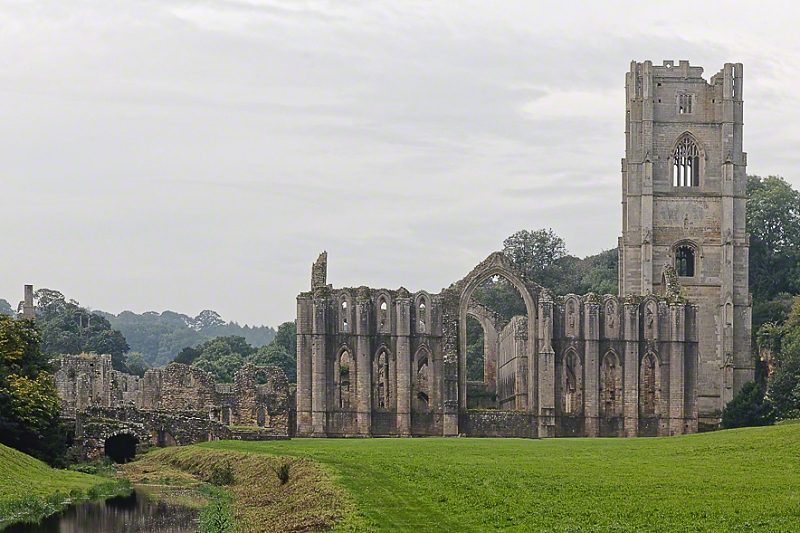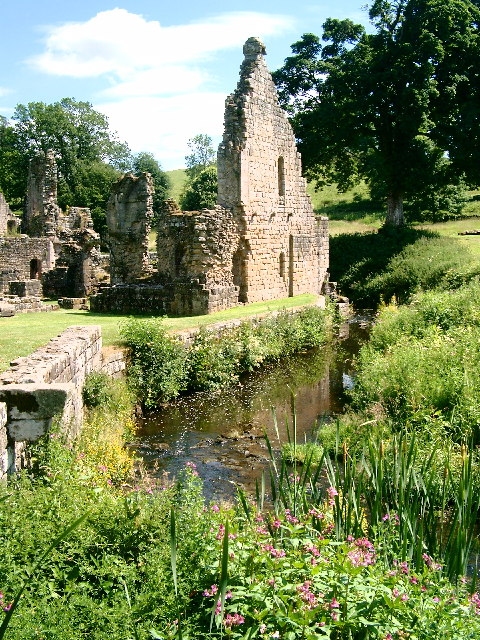
We arrive at the visitors' center at Fountains around 3:00PM and are badly in need of a snack. As we show our Heritage passes to a very kind lady in the admissions office, Robin is preparing Dana and I for the hike ahead of us. The abbey lies at the bottom of a very steep sided valley and the path we must take leads up, then down one side.
The woman, overhearing and perhaps looking us over and deciding we look a little rugged (in our defense it has been a long day), tells us about a car park further down the road, off the property, which is much closer to the Abbey. After a quick trip to the snack bar where Robin and Dana buy chocolate covered treats and I opt for a "flapjack," an oatmeal and date concoction, and a bottle of water, we head back to the car and down the hill toward the 'secret' car park.
I've heard of the trek to the abbey before, and am so grateful to the lady for telling us where to park. All we have to do is cross the street, show our receipts to another very kind woman stationed at the gate and proceed onto the grounds. We pass the manor house, a grand house by the looks of it, but we have no interest in viewing it, having toured one of the grandest of the grand earlier in the day.
My first view of Fountains is breathtaking and dramatic. I've seen pictures before, studied them so often I feel as if I have been here; but nothing could have prepared me for the enormity of the ruins. We pass the guest houses, surrounded by stately trees, pass under an arch, and then the columns and windows and arches rise up to greet me; spread out before me, like a feast on the plate of a starving man. The atmosphere is spellbinding. I wander around in a trance, feeling myself drawn back in time.
In 1132, thirteen monks had come to this hidden valley to start a simpler life. Over 400 years later when Henry VIII demanded the closure of the Abbey, the monks left behind what is now the most complete Cistercian abbey remains in Britain. Most of this 12th century Cistercian abbey ruin stands on the north bank of the River Skell, but the lay brothers' refectory stretches across the water to the south bank like a small bridge. Inside, a long narrow nave with arched aisles leads to the roofless Chapel of the Nine Altars.
It's perfectly peaceful and quiet as we wander around the grounds, but for the burbling of the river. I walk down to the water's edge and dip my fingers in the cool clear liquid. A smooth brown stone finds its way from the pebbled bottom, into my fingers and ultimately into my pocket. The banks of the river are bordered with colorful wildflowers, yellow and white, lavender and fuchsia all blended together in a pastel palette.
We snap photos and marvel at the fact that we are quite alone in our exploration of this place. This happens to us more often than not on this trip. I don't know if it is timing or karma or maybe just the fact that most of the places on my list of "must sees" are a bit off the beaten path. Almost everywhere we go, there are rarely more than a few other people. In this place though, the spirits of the holy men who lived here remain with the ruins, which are now prettily furred with moss and lichens.
As we prepare to leave, I lag behind a bit. I need a moment alone in this place that is so important to me. I spy a previously unexplored dark passageway and go up two stairs, entering a small room. There is enough space here for a narrow bed, or perhaps a writing table and stool, but little else. Dim light filters in through a narrow window. I close my eyes, let my ears fill with the sound of water on rock, and try to imagine who this space belonged to hundreds of years ago. A sense of serenity courses through me and I feel completely at peace. Now, I not only have a river – I have a room at Fountains. I feel as if I have been welcomed to claim it as my own and I do so now.
I rejoin Robin and Dana and we wander back out toward the way we'd come in. The cellarium, in which a maintenance worker had been puttering when we'd first arrived, is now empty. The cavernous chamber calls out to us ... verbally. A high pitched squeaking noise is echoing through the corridor and we wonder if there may be bats. Slowly, slowly we progress, looking furtively about, until we find the source of the clamor.
Pigeons have built nests on top of one of the arches and apparently it is mating season. We stand and watch for a while, feeling a little sorry for the exhausted female who walks and flaps back and forth along the narrow ledge, all the while being pursued by several males. We do notice, however, that she isn't flying away and finally decide that her forlorn lament must be a mating cry.
Bright sunlight greets us again as we emerge from the cellarium. We walk over the infirmary bridge and wind our way back around to the main path to the manor house. I turn for one more look at the ruins. Walking backward, I say a silent farewell. Goodbye Fountains ... I hope to return someday and visit you again. My heart fills near to bursting as the abbey disappears from sight.

Fountains Abbey is one of the largest and best preserved ruined Cistercian monasteries in England. It is located approximately 3 miles south-west of Ripon in North Yorkshire, near the village of Aldfield.
Founded in 1132, the abbey operated for 407 years becoming one of the wealthiest monasteries in England until its dissolution in 1539 under the order of Henry VIII.
The church and claustral buildings stand at the center of the precinct north of the River Skell. The inner court, containing the domestic buildings, stretches down to the river and the outer court, housing the industrial and agricultural buildings, lies on the river's south bank.
The early abbey buildings were added to and altered over time, causing deviations from the strict Cistercian type.
Read more about Fountains Abbey at Wikipedia.